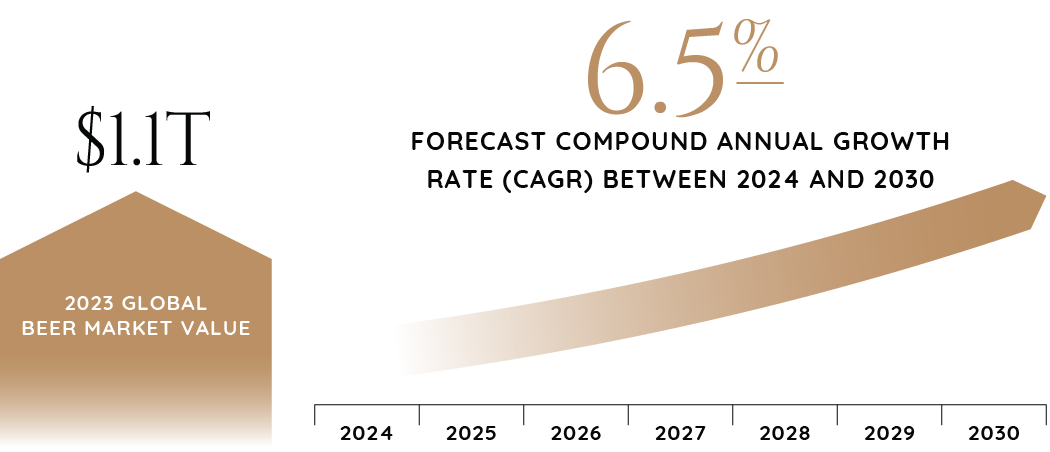The global beer market was valued at approximately $1.1 trillion in 2023 and is forecast to expand at a compound annual growth rate (CAGR) of about 6.5% between 2024 and 2030.
Segmentation
By Type:
- Ales
- Lagers
- Stouts & Porters
- Malts
By Packaging:
- Canned
- Bottled
- Draught
By Category:
- Mass
- Premium
By Distribution Channel:
- On-Trade
- Bars
- Restaurants
- Pubs
- Off-Trade
- Supermarkets/Hypermarkets
- Convenience Stores
- Specialty Stores
- Online Retailers

Market Trends and Drivers
Growth in the beer market is driven by several factors, including the increasing penetration of e-commerce, continued technological innovation, and growing populations. Some of the current trends in the market include the manufacturing of non-alcoholic beer, new products with natural additives and coloring agents, more use of e-commerce platforms, using artificial intelligence (AI) to make higher quality beer, and even the new trend of immunity-boosting beer.
A diverse range of products cater to a global audience, with the increasing popularity of craft beer and the emergence of more independent breweries. There is more attention being placed on evolving consumer preferences, especially among younger generations such as Millennials and Gen Z.
E-commerce has opened up more distribution channels for the beer market, creating new ways to reach customers and grow brand loyalty. Online stores and delivery services are making it easier for consumers to access products from home and get more craft alcohol options.
Your Business, Our Expertise – A Winning Combination.
A growing number of craft breweries are cropping up nearly everywhere, which will continue to fuel the expansion of the beer market. Craft breweries offer new choices, more innovation, a sense of local identity and community, and more options to suit consumer preferences. Craft beers are also perceived to be of higher quality due to their unique brewing processes, attention to detail, and seasonal and limited-edition offerings. According to the U.S.-based Brewers Association, the number of craft breweries reached a record-breaking 9,552 last year.
Environmental sustainability is another factor impacting the beer industry, as more breweries are looking towards eco-friendly practices, reducing their carbon footprints, and promoting recycling programs. Traditional glass bottles remain the favored packaging because they are able to preserve the taste and aroma of the beer.
As disposable incomes are increasing worldwide, they are driving the beer market. As customers have higher incomes, they tend to buy more premium and diverse beer options, which drives the segment's expansion in the emerging market. Urbanization has improved retail infrastructure in supermarkets and specialty beer shops, making it easier for customers to find a larger variety of beer brands.
Tourism plays a significant role in the beer market, as many tourists are looking for their own unique beer experiences. This has further increased the demand for craft breweries.
Thanks to automation technology, there has also been a rise in the trend of self-serve beer bars. This innovation addresses the need to improve customer experiences in crowded bars where ordering a drink may take a while. Self-serve beer bars allow customers to pour their own beer from taps arranged on a wall using touch screens and RFID card readers.
By Region
The Asia-Pacific region leads the global beer industry, as the larger market share is due to the higher beer consumption in countries such as China, South Korea, Japan, and India. This market is also being driven by growing populations, growing disposable incomes, and changing consumer preferences. There is also rising beer demand at events and social gatherings in the region. Additionally, the rapid urbanization and westernization in parts of Asian communities are leading to more consumption of beer products
M&A
The global beer market is on pace to see significant growth through 2030, creating many opportunities for investors. As the market expands in emerging economies, there will be opportunities for massive investments in breweries.
The beer industry used to be dominated by large, multinational brewing companies and distributors. However, craft breweries have shaken up the market with local, smaller brewery experiences that have become widespread and extremely popular. The major companies in the beer market are now focusing on product innovations to expand their portfolios of premium, higher-quality beers to increase their market share and get in on the craft beer scene. Rather than trying to compete with these smaller breweries, they are using strategic acquisitions to make it possible for these big companies to expand their market presence, adopt new technologies, and meet the increasingly diverse preferences of consumers. As major brands in the market work to aggressively capture business in emerging markets globally, it is expected to remain a trend in the coming years.
Categories
Get These Insights Delivered Directly To Your Email
Explore our curated collection today and stay ahead of the curve in M&A.
